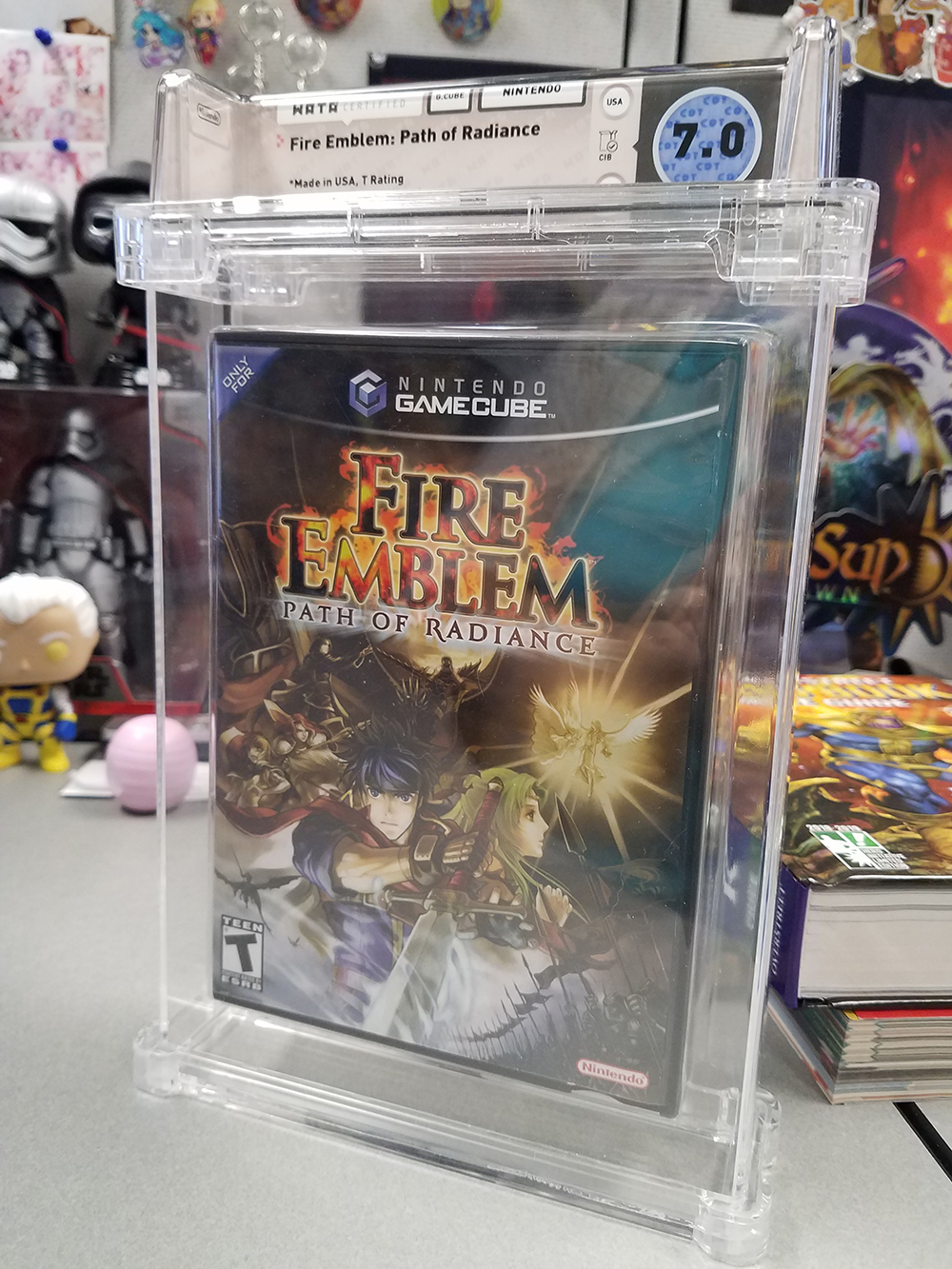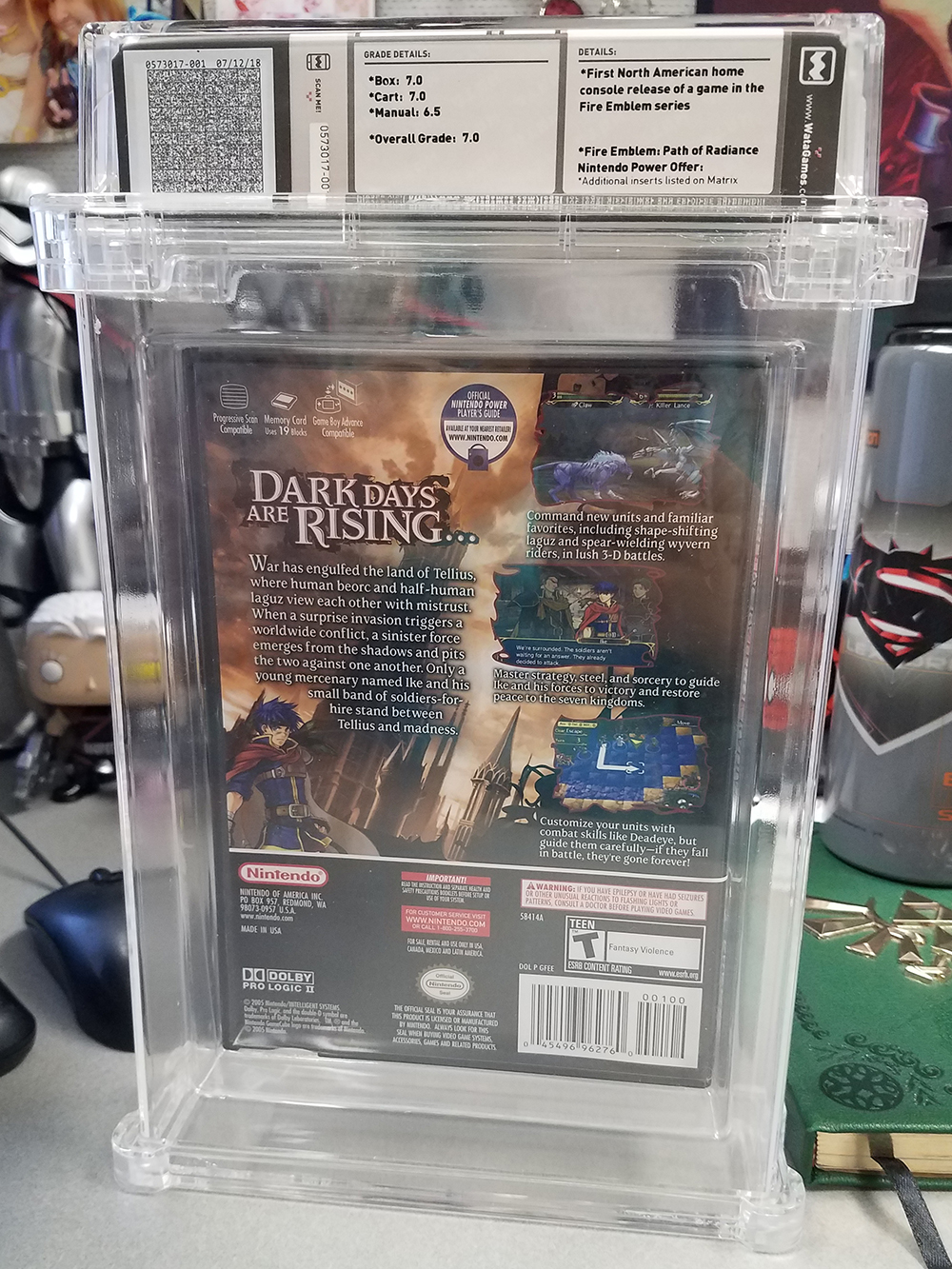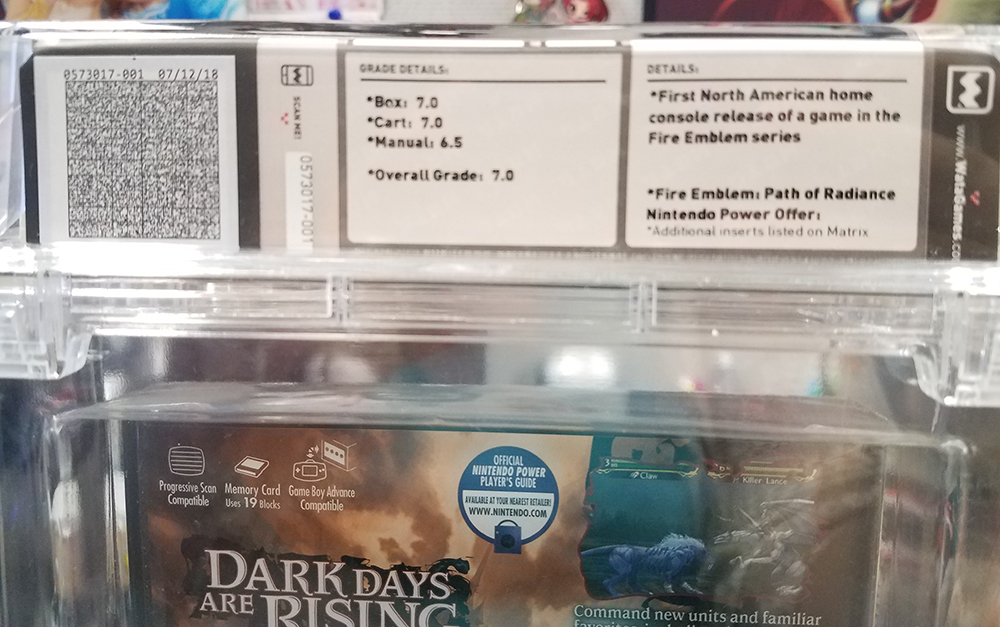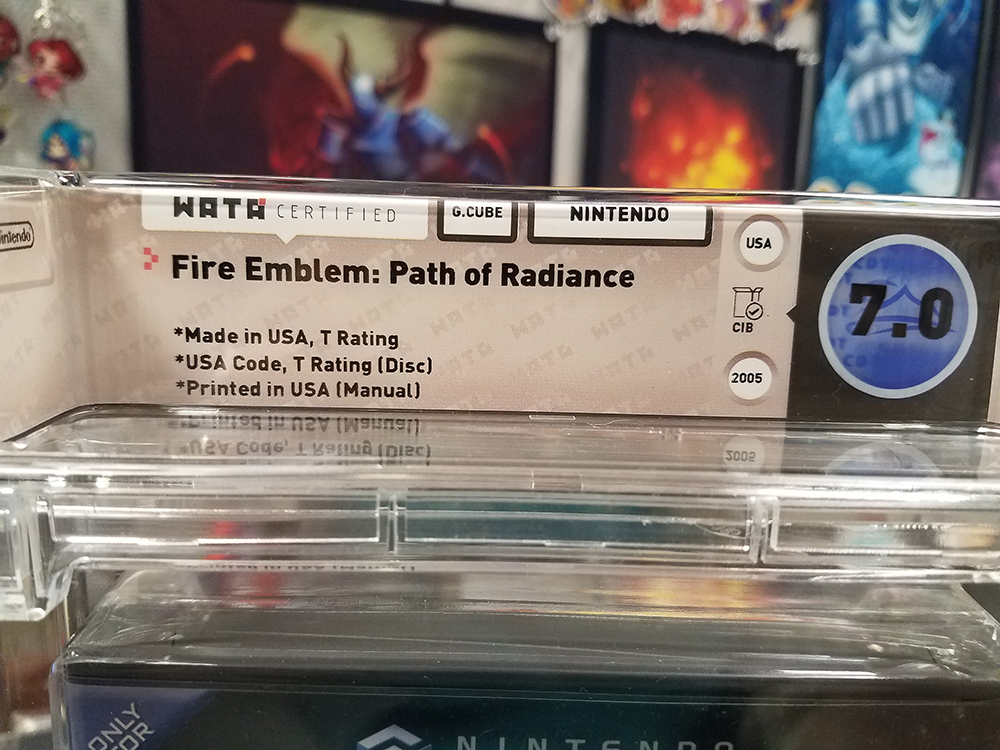
The idea of having a video game graded might seem totally foreign to many gamers. Why get a video game graded when it means that doing so will render the game itself unplayable?
While mass market video games have only been around since about the 1970s, collectors are quickly learning that various aspects of the physical games are requiring a significant degree of preservation. Cartridges crumble, discs deteriorate; ultraviolet rays can turn an NES yellow or fade away gorgeous box art. Having games professionally graded means that they will be preserved for the future and shielded from such damage. But while there have long been grading services for comic books, cards, and even action figures, there hasn’t been one to authoritatively offer such a thing for video games.
Enter Wata Games.
 This is a very new company, having launched just earlier this year at C2E2 in Chicago, but they’re out to a remarkably strong start. Wata is run by their President and CEO Deniz Kahn, a longtime collector and gaming historian who clearly saw the need for this sort of service within the video game secondary market. (Kahn’s experience as a collector is divulged in great detail in The Overstreet Guide to Collecting Video Games.) Kahn is assisted in this endeavor by a number of advisors with a lifetime of experience working for other collectible grading companies. Wata’s chief advisor is Mark Haspel, who was one of the three original members to help get CGC off the ground in the late ’90s and was President of the company from 2008-2011. Needless to say, the sort of people that Wata has on their staff helps to instill a significant amount of confidence in the service they provide.
This is a very new company, having launched just earlier this year at C2E2 in Chicago, but they’re out to a remarkably strong start. Wata is run by their President and CEO Deniz Kahn, a longtime collector and gaming historian who clearly saw the need for this sort of service within the video game secondary market. (Kahn’s experience as a collector is divulged in great detail in The Overstreet Guide to Collecting Video Games.) Kahn is assisted in this endeavor by a number of advisors with a lifetime of experience working for other collectible grading companies. Wata’s chief advisor is Mark Haspel, who was one of the three original members to help get CGC off the ground in the late ’90s and was President of the company from 2008-2011. Needless to say, the sort of people that Wata has on their staff helps to instill a significant amount of confidence in the service they provide.
I spoke to Kahn at C2E2, when Wata was making its grand public debut, and later in the year saw him at TooManyGames (where Wata was conveniently directly across from Gemstone in the exhibit hall). The offer had been extended to me to have a game of mine graded in order to experience the Wata Games service quality for myself, so I sent them my copy of Fire Emblem: Path of Radiance. This GameCube release is one of the more valuable titles as far as this system’s games are concerned, with (as of this article’s publication), loose discs without a box selling for $80 online, and complete-in-box copies fetching prices of $125 or more. As one of the more valuable games in my collection – and one I knew I was unlikely to want to actually play again – I thought this would be a good one to slab up.
 My game was sent back to me recently, and I’m beyond pleased with the results. I neglected to photograph how it arrived, but it was packed with the utmost care, with the slabbed game being sealed inside of a plastic bag, which was then wrapped in bubblewrap in a box that was then filled with packing peanuts. It’s a standard of care in packaging that was far beyond what I had expected, and before I even saw the game in its new casing I realized the kind of professionalism involved here.
My game was sent back to me recently, and I’m beyond pleased with the results. I neglected to photograph how it arrived, but it was packed with the utmost care, with the slabbed game being sealed inside of a plastic bag, which was then wrapped in bubblewrap in a box that was then filled with packing peanuts. It’s a standard of care in packaging that was far beyond what I had expected, and before I even saw the game in its new casing I realized the kind of professionalism involved here.
The casing used for my game is Wata’s 8” display case, which is also used for boxed copies of NES, SNES, N64, Genesis, 32X, GameCube, PlayStation, Xbox, Wii, and Wii U titles. Since games are hardly a “one size fits all” endeavor, Wata has four different box sizes; in addition to the 8” they also have a 9.35” (for Sega CD, Sega Saturn, and PS1 Longbox titles), a 6.3” box (for NES carts) and a 4.45” box (for SNES carts). Within the sizing are two different case styles, which are “3D/Banner” and “2D/Flat-Top” cases. The Banner case allows collectors to view all pertinent information on four different sides of the box, and doesn’t obscure any part of the game itself, while the Flat-Top is a more compact box that is good for those who need to save shelf space and allows collectors to scan the box for all of the information about the game within.
 My game was packed in the Banner box, which I like a lot. It prominently shows all of the information about the game on that big top label, and of course highlights the grade. The label makes sure to show the country of release, whether or not the game is complete-in-box or not, and also details any other bits of info that make the game a particular standout. The back of the label for Fire Emblem: Path of Radiance makes sure to note that it was the “first North American home console release of a game in the Fire Emblem series.”
My game was packed in the Banner box, which I like a lot. It prominently shows all of the information about the game on that big top label, and of course highlights the grade. The label makes sure to show the country of release, whether or not the game is complete-in-box or not, and also details any other bits of info that make the game a particular standout. The back of the label for Fire Emblem: Path of Radiance makes sure to note that it was the “first North American home console release of a game in the Fire Emblem series.”
The way that the game is packed into the case gives it the appearance of essentially “floating” within, due to a system-specific plastic insert for GameCube titles. Everything’s nice and tight in there – you can shake the box all you want, but it’s not going to budge. The box features archival quality UV protection as well as a two-way locking system. There are a total of six locking tabs in the case which makes it irreversibly locked and air-tight – and any sort of tampering, or attempts to tamper, extremely evident.
 Now, onto the most important part about the whole grading experience: the grade itself. Wata uses a 10-point grading scale that they devised themselves, but one that is clearly in line with the industry standard of grading used for comic books. It’s very straightforward and very easy to understand, and the website makes sure to show a variety of photos of games, boxes, and manuals at each different point in the scale in order to make sure that consumers understand the difference.
Now, onto the most important part about the whole grading experience: the grade itself. Wata uses a 10-point grading scale that they devised themselves, but one that is clearly in line with the industry standard of grading used for comic books. It’s very straightforward and very easy to understand, and the website makes sure to show a variety of photos of games, boxes, and manuals at each different point in the scale in order to make sure that consumers understand the difference.
My copy of Fire Emblem came in at a solid 7.0, which, as far as comics are concerned, would be considered “Fine.” Fine by me! Wata devises a total grade based on three different grades – one for the box, one for the game cart or disc itself, and another for the manual. My copy received a 7.0 for both the box and the game, and a 6.5 for the manual. I bought this game out of a preowned bargain bin when my local game store was purging their GameCube titles at the end of that console’s lifespan, so this is about what I expected. Despite taking very good care of my things, there’s nothing I ever could’ve done about what happened to this specific copy of Fire Emblem before I walked into the store that day.
While my copy was not factory-sealed, Wata does offer a secondary scale for sealed games with regards to the seal quality. This scale ranges from “A++” down to “C” and is an additional letter grade on top of the number grade assigned from the 10-point scale.
 Wata has a few different pricing tiers with regards to both declared value of the submitted game and turnaround time, with their most basic, the Select service, starting at just $25 for a loose game on a turnaround of 45 days. They also offer additional features for small fees, such as game testing (for just $5 they’ll test the game and apply an additional label confirming that the game works), post-grade photos, a grader’s report, and board photos. Perhaps my favorite little add-on is the $8 they charge for a gentle cleaning. In all of my years working at GameStop I learned all the best methods for keeping games and systems clean, but I imagine many people do not know these things, and given the boost to a grade that this could potentially provide, it may be worth the extra pocket change.
Wata has a few different pricing tiers with regards to both declared value of the submitted game and turnaround time, with their most basic, the Select service, starting at just $25 for a loose game on a turnaround of 45 days. They also offer additional features for small fees, such as game testing (for just $5 they’ll test the game and apply an additional label confirming that the game works), post-grade photos, a grader’s report, and board photos. Perhaps my favorite little add-on is the $8 they charge for a gentle cleaning. In all of my years working at GameStop I learned all the best methods for keeping games and systems clean, but I imagine many people do not know these things, and given the boost to a grade that this could potentially provide, it may be worth the extra pocket change.
I love video games, but I’m not what I think anyone would consider a particularly hardcore collector. I buy the games that I love and I do what I can in order to keep them looking their best. I never thought that video game grading would appeal to me, but my experience with Wata Games may have changed my mind on that. Their website is easy to understand and it makes their whole process totally transparent – and it’s nice and super reassuring to see an advisory board full of notable faces from other facets of collecting.
Many gamers are sure to continue to wonder why such a service is necessary. And certainly, video game grading isn’t for everyone. For me, I know which of my games I’ll continue to play, and which I’m likely to retire to a lifetime of display-purposes only. Deniz Kahn and his staff of experts over at Wata Games clearly know what they’re doing and I cannot possibly recommend them enough if you’re interested in having video games graded. Their professionalism is evident, their process is as transparent as you can hope in a grading service, and it’s clear that they love what they do. I hope to continue to see this company grow within the next few years!
-Carrie Wood











